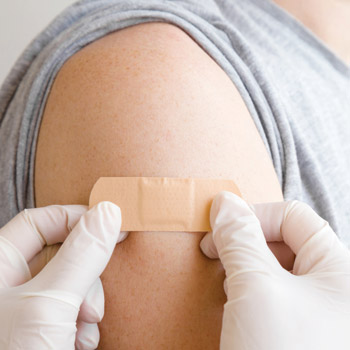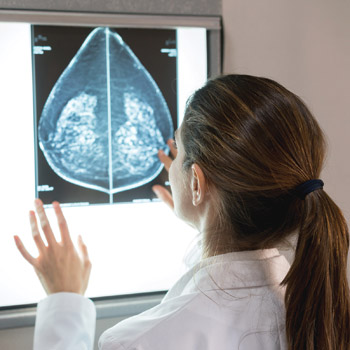Raising vaccine rates requires some selling
Physicians and others in their practice can boost their odds of vaccination success by the way they frame conversations with patients.
Jason Goldman, MD, FACP, doesn't mince words in trying to convince his more recalcitrant patients to get their vaccines, with the annual flu shot frequently the toughest sell.
Getting vaccinated against the flu is much like wearing a seat belt, Dr. Goldman will tell them. “You can still get in a car accident, but the seat belt is going to help decrease your chance of a bad outcome,” said Dr. Goldman, a general internist in Coral Springs, Fla., and Governor for ACP's Florida Chapter.

Sometimes, though, even his best efforts don't work. “I have patients who still refuse the flu shot. I don't know why,” he said.
Vaccines have been at the forefront of everyone's mind in recent months, with the emergence of COVID-19 and the search for a vaccine to fight it. Yet many adults don't stay up to date with the preexisting vaccine regimen for other diseases.
Numerous factors likely play a role. The immunization schedule is regularly updated by federal officials, making it more difficult for physicians and patients to keep track. Physicians must handle the purchasing and safe storage of the vaccines, along with reimbursement issues. Patients don't always remember what vaccines they have already received, and their histories can be difficult to locate, particularly as other sites, such as pharmacies and workplaces, now offer some of the shots.
Plus, physicians addressing other medical ills have scant time to discuss vaccines when they encounter a patient not sold on the benefits. “There is a lot of vaccine hesitancy out there,” said Robert Hopkins Jr., MD, MACP, who practices internal medicine and pediatrics at the University of Arkansas for Medical Sciences in Little Rock.
During the 2016-2017 flu season, just 45.4% of all adults ages 19 years and older got a shot, and the uptake proved lower among African-American (38.5%) adults and Hispanic (37.0%) adults, according to the most recent data available from the National Health Interview Survey. Slightly more than two-thirds of adults ages 65 years and older had received a pneumococcal vaccine. Among adults ages 19 years and older, 63.4% were up to date on their tetanus vaccine.
There's already discussion that the stakes may be even higher for the coming influenza season, with COVID-19 likely still circulating. In April, former FDA Commissioner Scott Gottlieb, MD, noted in a tweet that the risk of co-infection with the flu and COVID-19 should provide a compelling reason to convince more people to get the influenza vaccine.
Physicians and others in their practice can boost their odds of vaccination success overall by how they frame these conversations with patients, said Dr. Hopkins, who is a faculty member on ACP's “I Raise the Rates” campaign promoting adult vaccination.
“You need a strong, succinct recommendation and also to give them the ‘why,’” Dr. Hopkins said. “I would say, ‘It's flu season. I want you to have a flu vaccine today. I don't want to see you in the hospital with pneumonia or with your diabetes out of control because you've got the flu.’”
Vaccine updates
In its latest vaccine schedule, approved last fall, the Advisory Committee on Immunization Practices (ACIP) made some changes to pneumococcal, human papillomavirus (HPV), and other vaccine recommendations, with a focus on shared decision making for some, according to an overview of the changes published March 3 by Annals of Internal Medicine.
For instance, a shared decision-making approach is part of the latest guidance regarding one of the pneumococcal vaccines in older adults, said Carolyn Bridges, MD, FACP, a Boise, Idaho, internist who chairs ACP's Immunization Committee. While adults ages 65 years and older should continue to get a single dose of the PPSV23 (pneumococcal polysaccharide 23-valent) vaccine, ACIP now recommends PCV13 (pneumococcal conjugate 13-valent) vaccine based on shared clinical decision-making instead of routine vaccination at age 65 years.
One major reason is that the introduction of pneumococcal conjugate vaccines in children, starting in 2000, has resulted in a notable decrease in infections among adults ages 65 years and older, according to data published Nov. 22, 2019, by Morbidity and Mortality Weekly Report (MMWR). From 2000 to 2014, there was a ninefold decline in the pneumonia strains targeted by the PCV13 vaccine in adults ages 65 years and older.
Adults ages 19 years and older with immunocompromising conditions such as functional or anatomic asplenia, cerebrospinal fluid leak, or cochlear implants should continue to get the PCV13 vaccine, Dr. Bridges stressed. Otherwise, she said, physicians “should talk about the patient's individual risk.” Patients might still want to get the vaccine if they are considered more vulnerable to infection due to other chronic conditions, because they live in a nursing home or long-term care facility, or because they travel to regions with low childhood PCV13 vaccination rates, she said.
Some other changes were made to boost protection against HPV, Dr. Bridges said. ACIP now recommends catchup vaccination for all adults—males as well as females—through age 26 years. (Previously it was recommended up through age 21 years for all males, through age 26 for males with certain risk factors, and through age 26 years for females.)
Ideally, both boys and girls should be fully vaccinated during adolescence, and by age 26 years at the outside, according to the latest ACIP recommendations for these age groups, which were published Aug. 16, 2019, in MMWR. But even sexually active adults might have been exposed to some but not all the strains in the vaccine, the MMWR authors wrote. Thus, ACIP also recommended a shared decision-making conversation with some unvaccinated adults ages 27 through 45 years at increased risk of new HPV infections, such as if they have a new sex partner.
Primary care doctors are well positioned to initiate these conversations, as they already have a sense of their patients' life circumstances, said Sandra Adamson Fryhofer, MD, MACP, a general internist in Atlanta and a liaison to ACIP.
“This is an expensive vaccine,” Dr. Fryhofer said. “The older patients would need three doses. But, for example, for someone who is widowed or divorced and is going back into the dating world, getting the HPV vaccination series might be a consideration.”
Some other changes to the 2020 schedule, with more outlined in the March 3 Annals summary, include that either a tetanus-diphtheria (Td) shot or a tetanus-diphtheria-pertussis (Tdap) vaccine is acceptable as a 10-year tetanus booster for adults and that anyone with HIV should get vaccinated against hepatitis A.
Physicians also should touch base with their patients on upcoming travel plans in case they might need a typhoid or a yellow fever vaccine, among others, Dr. Fryhofer said. Which vaccines are recommended will vary by destination, so it's best to check the CDC's online guidance for the latest, she said.
“Travel plans and travel history should be an additional vital sign,” said Dr. Fryhofer, noting that such questions will become relevant again once COVID-19 wanes. “I think it's brought me closer to my patients because it's interesting [to discuss travel plans], and I can make sure they are safe.”
Practices can also post information in the waiting room, reminding patients to notify their doctor of any upcoming travel out of the country, ideally four to six weeks before they depart, said Vidya Sundareshan, MD, FACP, co-chief of the division of infectious diseases at Southern Illinois University School of Medicine in Springfield. Otherwise, patients may try to come in for their vaccines too close to the trip, she said.
Even after the pandemic wanes, she said, “I think there's going to be heightened awareness of diseases which you can contract and bring back home.”
Building a robust program
The vaccination schedule has become increasingly complex for time-pressed physicians, with more vaccines and nuanced indications, Dr. Goldman said. “Doctors must take the necessary step to look at the vaccine schedule, understand it, and be able to embrace it,” he said. “That's one hurdle, the willingness for someone to learn it.”
Physicians also worry about reimbursement, Dr. Goldman said. “You are not going to retire on vaccines,” he quips. But with some practice organization and advance planning, physicians can provide vaccines with “a very slim profit margin” after covering their purchase, storage, staff time, and other costs.
One strategy is to purchase the vaccines directly from the manufacturers rather than through a third-party vendor, Dr. Goldman said. While one-stop shopping with a single vendor is more convenient, it will typically cost more, he said.
To hold down costs, physicians can purchase the vaccines through a group purchasing organization, Dr. Goldman said. Set up automated credit card payments, but negotiate deferred payment with the manufacturer, he said. That way the first batch of vaccines will have been administered and reimbursed for before that first payment is due. Discounts may be provided for prompt bill paying and purchasing several vaccines from one manufacturer, he said.
Staff will also need to be trained, including about proper handling and storage, said Dr. Goldman, who recommends online resources from the CDC. Someone in the practice, whether that's a nurse, administrator, or other staffer, can be designated as a vaccine champion. When prepping the charts before each appointment, that staffer can flag which patients need a vaccine.
One perennial challenge is figuring out what vaccines the patient got previously, Dr. Goldman said. Ideally the physician can access the patient's prior medical records. Most states have an immunization registry that can be checked, but those aren't always complete, as the vaccines will only appear there if they have been entered by the previous clinician, he said.
Boosting patient buy-in
Vaccines shouldn't just be the responsibility of primary care physicians, Dr. Hopkins said. Cardiologists, gastroenterologists, and other subspecialists should check that their patients are up to date. Physicians can set an example by making sure their staffs are vaccinated and emphasizing that vaccination is a priority of the practice, he said.
That vaccine connection can be made from the start, when a patient checks in and is chatting with the front desk clerk, Dr. Hopkins said. “She can set things up as, ‘You know that Dr. Hopkins is going to want you to have that flu shot today?’”
Dr. Hopkins said his practice tries to make getting a shot as easy as possible, by sending out a message through the electronic medical record each flu season that they are running a walk-in immunization clinic. Patients also can get their pneumococcal and Tdap vaccines at the same time, he said.
Still, some adults remain difficult to sway, Dr. Goldman said. “The reason that I'm so passionate about vaccines is I've had 18-year-olds die from the flu who didn't get vaccinated, 18-year-olds who were athletes.”
Nor is Dr. Goldman convinced that vaccine resistance will ease much, even amidst a pandemic.
“I would like to think so,” he said. “But I don't know that it will necessarily help because there is a vocal segment of the population that just does not trust, believe, or listen to what scientists and the medical community have to say.”



